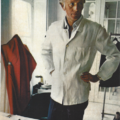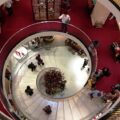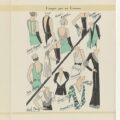Jacques Doucet Fashion designer
August 9, 2016Jacques Doucet (1853-1929) was a celebrated fashion designer, known for his excessively decorative, immensely expensive Belle Epoque dresses smothered in ribbons and lace with tiny waists and voluptuous bosoms. His peak was in the late nineteenth century and his compatriots were Charles Frederick Worth, Raudniz & Co, Jeanne Paquin and Beer & Co.
Both Paul Poiret and Madeline Vionnet, celebrated fashion designers of the 1910s and 1930s respectively, worked in his atelier for a time. But Doucet, a third generation clothing designer, preferred exquisite art and antiques to clothes and desired to be known to the world at large as an aesthete and gentleman, eventually letting the family business which provided the money for his passions close down through his disinterest.
Jacques Doucet – the couturier who dressed royalty but was ashamed of his job
Jacques Doucet came from a venerable background in clothing and haberdashery. As a young couple his grandfather and grandmother had officially set up a fashion-related business in about 1817, whose origins are a little mysterious – perhaps they had a tray and hawked hats from a doorway in a busy Parisian street, or perhaps, a little more respectably, their business was a market stall selling lace. In any case, by 1824 Antoine Doucet and his wife Adele Doucet are documented as making and selling lingerie and fashionable items on one of the best shopping streets in Paris.
A family business
This business grew, mostly on the back of ready made lingerie and men’s shirts but also embroidered fabrics, lace, layettes, trousseau objects, braces, hosiery, collars and gloves. Soon it included three shops and a suite of workrooms. The Doucets kept it proudly in the family, and of their six children Jaques’ father, Edouard, was to directly carry on the family business, whilst his uncle Albert also worked there initially and eventually set up a rival shirt makers.
As the business became established, Antoine and Adele actually ran connected but separate businesses under the same label, with Antoine concentrating essentially on menswear and Adele on the lady’s side of things.
Royal Patronage
When Edouard took over the Doucet business in 1853, he was keen to modernise and use the latest in marketing. He initially managed both sides but leaned more towards menswear, calling the enterprise a tailors (although it still sold all kinds of lady’s desirables) and gaining the patronage of Emperor Napoleon III for its shirts. His Majesty the King of Bavaria, His Majesty the King of the Netherlands, and His Imperial Highness the Grand Duke Constantin of Russia were also fans.
But when his father Antoine died in 1868, Edouard immediately dropped men’s haberdashery, and only a year later he sold the menswear business entirely, complete with Doucet name. Instead he began to concentrate on his mother’s side of things. Adele, who died that year, had built up an equally formidable lady’s lingerie business. Edouard took this and made the leap of adding couture womenswear. The top fashionista of the time Empress Eugenie was a fan of Doucet underwear, and now the Queen of Wurtenberg was wearing their dresses.
Edouard proudly proclaimed that Doucet was now the couturier to go to for women of the highest levels of society.
The Next Generation Doucet fashion designer
Edourd had three children – Jaques, his eldest, a daughter, Marie, and a younger son who died in infancy. Jacques Doucet was initiated into the family business the same way that his father had been as soon as he became old enough, and inherited it in 1898, the year that Edourd died.
Jacques was overwhelmingly influenced by the 18th century and cultivated what he felt to be the taste and manners of a bygone age. He dressed immaculately in shoes that were re-laquered daily, white spats, white waistcoat and a beard so perfectly manicured it was compared to the hedges of a royal park.
A collector and aesthete
Jacque Doucet stated that he grew up among pigs. In fact, his upbringing was hardly squalid, but perhaps he found his merchant origins demeaning. He was given a private education and learned about art, but although he studied painting he was no more than adequate at it himself. So he evidently turned to collecting to satisfy his artistic urges, as dress design didn’t seem to do it for him. He never let the two worlds of his fellow collectors and his couture clients meet, and didn’t let his couture clients, however exalted, come to his house. He didn’t even speak to them of his collections or passion for art. He started listing himself in official directories as “retired” in 1895, at the age of only 42, although he never officially did retire from his business, simply absenting himself from its running more and more as time went on.
18th century antiques and paintings
Jacques Doucet was an avid collector of fine things. Photographs of his home resemble the richest stately homes, with silky wood parquet covered in gorgeous silken rugs, ornately carved marble fireplaces surmounted by ceiling high gilded mirrors in which twinkling chandeliers are reflected. Stately pillars support the ceiling which has ornate plaster mouldings and of course a painted frieze, and the walls that are not wood panelled are hung in silk. Ornately carved and gilded Louis XV furniture is dotted around the room with equally ornate objects disposed upon it.
But despite all these things to catch the eye, the most astounding is Jacques Doucet’s art collection. The man whose grandparents were said to be street peddler has his silk hung walls crammed to the ceiling with original oils, marble reliefs, pastels and watercolours by luminaries of the 18th century art world including Francois Boucher, Francisco Goya, Jean-Honore Fragonard and many others, and it is a shock to see some of their most famous works peering back at you from these luxurious walls.
Jacques Doucet-historical prototypes
His design style for the dresses the House of Doucet produced also hearkened back to the Eighteen century, which alongside the seventeenth century was a style generally in vogue with the fashionable women of the moment. Many Doucet dresses actually faithfully followed historical prototypes.
“The new gowns are composition in style. They represent the dress worn under… Louis XIV, Louis XV, and Louis XVI of France. Some gowns have features taken from the styles of each of these three reigns but there are Louis XVI dresses imported that are literal copies of those worn by Marie Antoinette and the beautiful women of her court. Other dresses similarly will, however, omit the striking feature of the originals and will have large-topped sleeves not unlike those of recent seasons.” Harper’s Bazaar, 1895.
A Collector of Historical Dress
Minutely examining such garments in order to reproduce them was not a problem for Doucet as it may not surprise you to hear that he owned original silk court gowns from the Louis XV and Louis XVI periods, and not only that but was the Societe de l’Histoire du Costume’s founders, officials, and major donors.
Lingerie Designs
Like most designers, Jacques Doucet had a core design style and for thirty years or so, he was at the top of his tree for his immense attention to detail and use of the most exquisite fabrics imaginable. As he was brought up in the business and particularly the lingerie trade he had the advantage of being steeped in the knowledge of fine and delicate fabrics, lace and ribbons and whether he liked the influence or not, there’s no denying that luxurious lingerie fabric like fine muslins, translucent georgette silks and heavy silk satins were his favourite. He even preferred traditional lingerie colours like blush pink and peach, ivories, whites, neutrals and pastels.
Dream Gowns
He also would have learned about fabric cut and construction during his formal initiation into the business as a young man and the infrastructure of the Doucet business, being complete with workrooms, seamstresses, suppliers and accountants meant that he did not have to spend time or thought on the tedious side of sourcing and setting all these things up, but could concentrate only on creating the gowns of his dreams. Of course his dreams were mostly of the highly decorated eighteenth century woman of means and luckily the nineteenth century woman of means concurred that a small waist, bell shaped skirt and generous bosom displayed in lingerie fabrics was exactly what she wanted too.
A banquet for the eye
He favoured a high quality supple silk from Liberty & Co in London and his dresses were bedecked in layers of detailed embroideries and appliqués with themes taken from nature such as flowers, wheat and even a swarm of bees climbing a skirt. Antique and modern lace, crochet and needle lace were often all used on one garment in collars, frills, jabots, ruffles and edgings. Some of his layering of these elements was so over the top that they have been described as “a banquet for the the eye, with a good possibility of indigestion”.
The salon where clients came for fittings was equally bedecked in luxurious pink swags and tiny gilt chairs.
House of Doucet, an Expensive Habit
As well as silks and satins, Doucet was well known for working with fur as if it were cloth, cutting and manipulating what is a bulky and unforgiving fabric into flattering forms. But more surprisingly, the House of Doucet also excelled in the opposite, notably severe, perfectly tailored clothes in quiet wool. In fact, Jacques Doucet was said to have invented the tailored suit for women. He never scrimped on quality and was a demanding perfectionist to work with and in return, his prices were sky high, although he had a sliding scale charging Americans the most, one minor member of the European Royalty was forced to pawn her family jewels to pay his bills one season.
Jacques Doucet clients
Jacques Doucet dressed European royalty, many of the American rich such as the Vanderbilts, and had the dubious honour of being widely directly copied by ladies of fashion’s dressmakers. But he most famously dressed theatre actresses, propelling them to fame for their seductive femme fatale wardrobes. His theatre costumes included those for Sarah Bernhart for La Dame aux Camelias and the great comedienne Rejane (born Gabrielle-Charlotte Reju) in Zaza, and many others including Liane de Pougy.
At his height Jacques Doucet employed five hundred people and had branches in both Paris and the fashionable seaside resort of Trouville.
Doucet and Paul Poiret
Doucet did not design the entirety of his collections alone. He had several “Modelistes” to assist him. One of these was Paul Poiret. who worked with Doucet from 1896 to 1900. He left to go to the House of Worth and went on to launch his own salon in 1903, where he perhaps learned from Doucet in his use of expensive materials like heavy silks and furs, and certainly in pricing – he seems to have taken Doucet’s crown as one of Paris’s most expensive dressmakers.
But his colours were the opposite to Doucet’s, bright and jewel-like where Doucet’s were muted, and his shapes were loose and modern, requiring that the wearer did not wear shaping underwear beneath, where Doucet’s were highly fitted to a tiny, corseted waist and showed an elevated bosom to distinct advantage. Curiously, Doucet’s eye for detail seems to have escaped Poiret entirely too, as for all his sky high prices his garments were notoriously shoddily made.
Poiret imitated the older man in his personal styling, adopting a neat beard, mirror polished shoes and patronising the same tailor. Doucet was perhaps flattered, and in any case lent the young designer the large sum of 500 francs whilst he was in his employ.
Jacques Doucet and Madeline Vionnet
A different proposition was Madeline Vionnet. Her stint at Doucet was from 1907 to 1912, when she opened her own salon, and her preference too, was for the heavy satins and not the floaty silks. She prefected bias cutting influenced by a much early fashion source than Doucet’s eighteen century muses – the Ancient Greeks. Unlike Poiret she did’t like bright colours and always retained Doucet’s preference for pure ivory and white gowns, along with pastel tints.
Her first collection for the head designer in 1907 caused a futureshock sensation amongst as thinly veiled barefoot models without underwear paraded in front of them, draped in silks that didn’t conceal the natural body shape. I imagine that to clients the models may as well have been naked. Anything more different to the highly constructed and fussily decorated usual Doucet garments can’t be pictured, and I can’t quite imagine how it came about. Vionnet’s work would undoubtedly have been beautiful, but her own heyday was to be the Thirties – she was thirty years ahead of her time here. It’s like, I don’t know, early Gareth Pugh designing inflatable latex dresses with full face masks for a very staid brand like Chanel in the 1980s, when it was all structured suits with shoulder pads and pussycat bows.
Jacques Doucet moves on
This previous photograph of the works in situ is from a catalogue of Doucet’s collection published in 1912, and the grand house is one specially built for Doucet in 1906. But it records works that were startingly sweepingly sold off that year – why, isn’t officially recored but gossip suggested that it was because Doucet had a much younger lover who disliked the “old fashioned” possessions.
Art wise, Doucet, then nearly sixty, changed an obsession of a lifetime and abandoned romantic 18th century paintings, skipped the nineteenth century entirely and went directly to the twentieth to go in for modern art, collecting Picasso, Braque, Miro, Ernst, and many other then-contemporary greats who were as shocking at that point as anything by an experimental young artist is today. He also displayed disparate objects from around the world along the lines of those which inspired those artists like African tribal artefacts, archaic Chinese paintings, and Persian ceramics.
Not to do things by halves, he redesigned his house decor to the latest interior decorations fashions, in impeccably sumptuous style: a visitor of 1929, Aline Meyer Liebman describes an entrance hall with a floor of silvered glass with a design in red glass inlay, and a metal staircase in a “wonderful design” with panels of black engraved glass. A shelf was made of “beautifully arranged glass strips in lovely color effects lighted from behind” and the was a door “made of cylindrical glass tubing backed with plate glass. – Designed by Legrain and Doucet.” Doucet was as delighted to show off his new acquisitions, taste and style as he had been his former.
Jacques Doucet and Art Deco
However, surprisingly, Doucet did not keep up with the same changes in the fashion world, and continued to wish to drape his clients in traditionally feminine lace, ribbons, chiffon and organza. In the 1920s he didn’t notice that skirts had become shorter, and that the free spirited women of the age rejected his proposed encumbrances, frills and flounces, preferring a cleaner line.
It didn’t help that Doucet’s preference for art over fashion lead to him becoming an absentee creative and administrative director, those actual duties being taken over by the very capable M. Jose de la Pena de Guzman, the house fitter and one of its designers, and Charles Pardinel, on admin duties. In 1924 Doucet merged with a smaller house, Doueillet. The new business struggled on, but with nowhere near the prestige of Doucet, and closed down in 1932. Jacques Doucet himself died in 1929, still dapper, still pretending he wasn’t a fashion designer, and still showing off his incredible art collection to all who wished to see it with pride.
An engraving of an 18th century style outfit by Doucet in Gazette du Bon Ton.
Paul Poiret afternoon dress designed for Doucet. Illustrated in Gazette du Bon Ton.
Jacques Doucet by Man Ray. Photo © Man Ray Trust:Artist Rights Society (ARS), New York:ADAGP Teleimage, Paris 2014
The 1906 mansion
Ball gown of about 1898 -1902.
Jacques Doucet Tea gown c 1907.
Doucet Ball gown, 1897. Collection of the Metropolitan Museum of Art.
Paul Poiret’s matching look.
Vionnet designed dress for Doucet, illustrated in Gazette du Bon Ton.
Doucet’s Art Deco studio.
Jacques Doucet’s Art Deco entryway, 1929 photograph by Pierre Legrain












